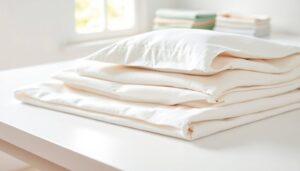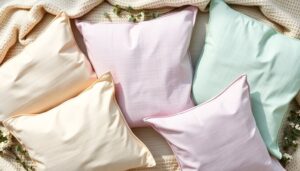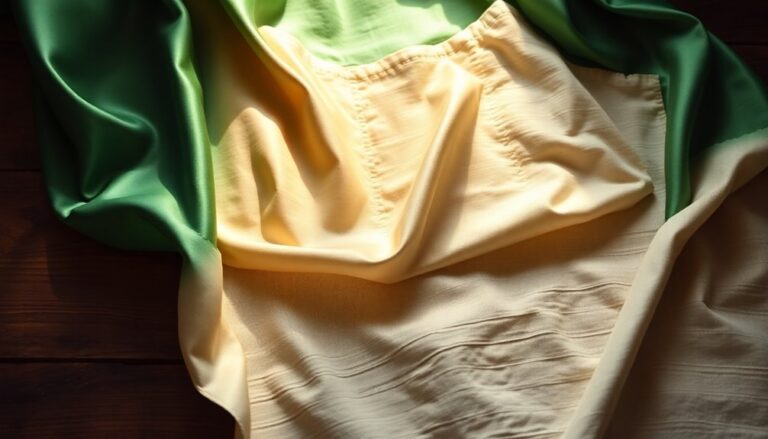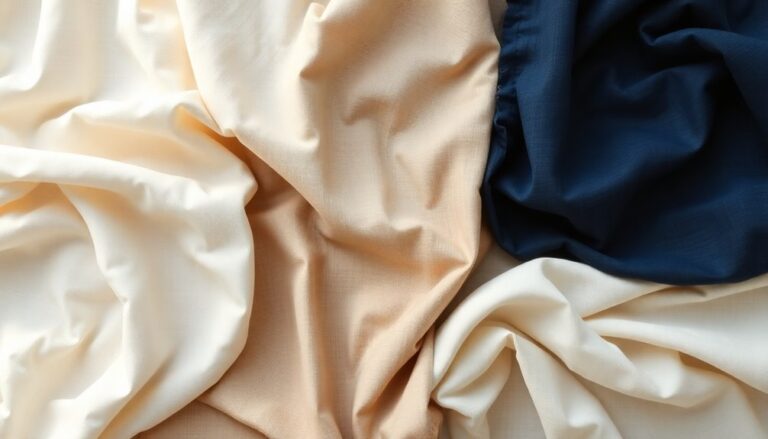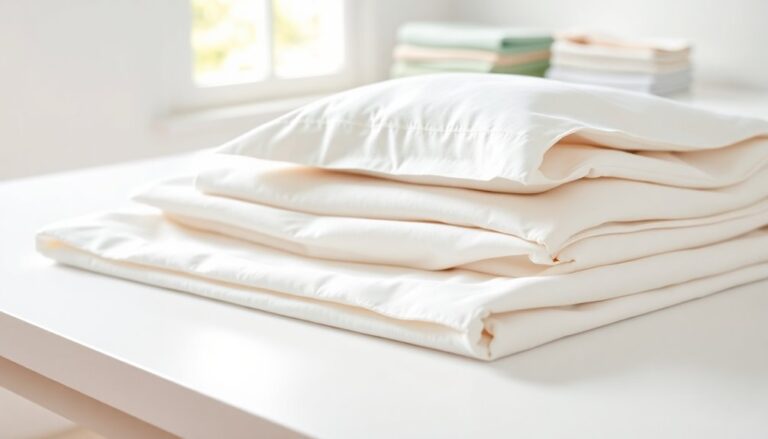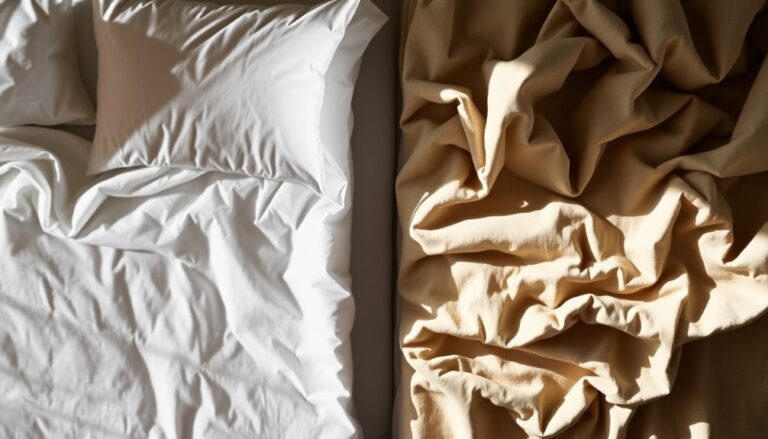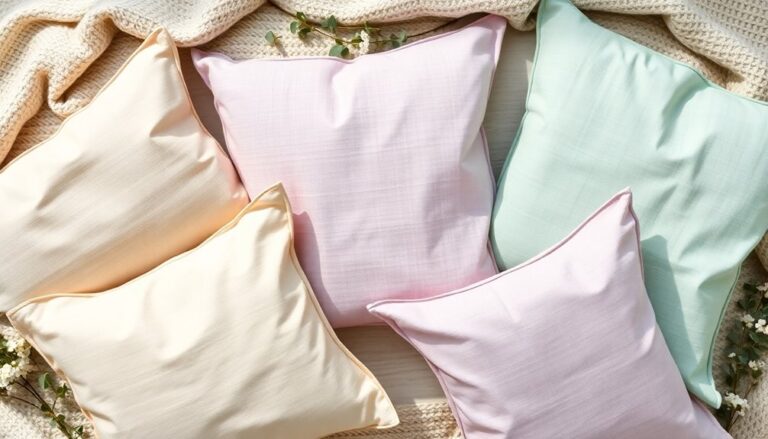Linen and polyester illustrate the importance of fabric choices, especially regarding natural fibers. Linen's breathability, moisture-wicking, and hypoallergenic characteristics make it ideal for sensitive skin, whereas its biodegradable nature supports sustainability. Conversely, polyester's affordability and durability come at the cost of breathability and environmental impact. Consumers who value comfort and eco-friendliness often lean in the direction of linen. To uncover more about these fabrics and their implications for your wardrobe, one can explore further.
Article Highlights
- Natural fibers like linen offer superior breathability, enhancing comfort, especially in warm climates, compared to polyester's heat-retaining properties.
- Linen is biodegradable, reducing environmental waste, while polyester can take hundreds of years to decompose, raising sustainability concerns.
- The hypoallergenic nature of linen benefits sensitive skin, unlike polyester, which may aggravate allergies due to its synthetic composition.
- Ethical sourcing and sustainable farming practices associated with linen support fair trade and local economies, contrasting with polyester's often unethical production methods.
- Linen develops unique character over time, appealing to consumers seeking quality and durability, while polyester offers low-maintenance but less aesthetic value.
The Benefits of Natural Fibers
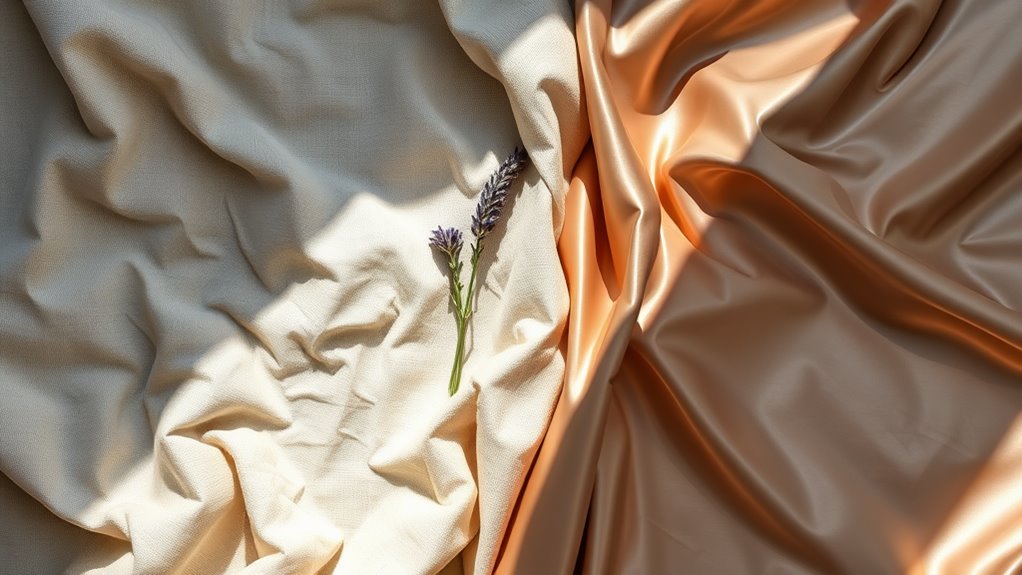
When it comes to choosing fabrics, many people prefer natural fibers like linen for their numerous benefits. One major advantage is their breathability; these materials allow air to circulate, keeping the body cool and comfortable. Natural fibers likewise tend to be more absorbent, which helps wick away moisture and regulate temperature. Moreover, they're often hypoallergenic, offering health benefits for those with sensitive skin or allergies. Unlike synthetic options, natural fibers are biodegradable, making them an eco-friendly choice. In addition, they tend to improve with age, developing a unique character that many find appealing. Overall, the natural fiber advantages, including comfort, health benefits, and environmental impact, make them a popular choice among those who value quality and sustainability in their fabrics.
Understanding Linen: Characteristics and Qualities
Linen, renowned for its unique texture and durability, stands out among fabrics for several reasons. Its natural fibers provide remarkable linen breathability, making it an ideal choice for warm climates. The linen texture is both crisp and soft, offering a luxurious feel that improves with each wash.
| Characteristic | Description |
|---|---|
| Breathability | Excellent airflow, keeps cool |
| Texture | Crisp initially, softens over time |
| Durability | Strong, withstands wear and tear |
These qualities not merely improve comfort but additionally guarantee longevity, setting linen apart from synthetic alternatives. Comprehending these characteristics helps consumers appreciate why linen remains a favored choice in textiles.
The Allure of Polyester: Pros and Cons

Whereas linen boasts impressive qualities, polyester offers its own set of advantages and drawbacks that appeal to different needs and preferences. One major benefit of polyester production is its cost-effectiveness; it's typically cheaper to produce than natural fibers. This affordability often translates into a wide variety of options for consumers, showcasing polyester's fabric versatility. It's resistant to wrinkles, mildew, and shrinking, making it a practical choice for everyday wear. Nevertheless, some downsides include its tendency to retain heat and lack breathability, which can be uncomfortable in warmer climates. Furthermore, polyester's synthetic nature raises concerns for those who prioritize natural materials. Ultimately, comprehending these pros and cons helps consumers make informed choices based on their specific requirements and lifestyle.
Environmental Impact of Fabric Choices
When considering the environmental impact of fabric choices, it's essential to examine the biodegradability of materials like linen and polyester. Each fabric has different levels of resource consumption and contributes uniquely to pollution and waste generation. Comprehending these factors can help consumers make more informed decisions about their textile options.
Biodegradability of Materials
Although both linen and polyester serve as popular fabric choices, their environmental impact considerably differs, especially regarding biodegradability. Linen, derived from the flax plant, is a biodegradable material that breaks down naturally, offering significant environmental benefits. Conversely, polyester, a synthetic fiber, can take hundreds of years to decompose, contributing to landfill waste.
| Material | Biodegradable | Environmental Benefits |
|---|---|---|
| Linen | Yes | Reduces landfill waste |
| Polyester | No | High durability |
Choosing biodegradable materials like linen helps promote a healthier planet. By comprehending these differences, consumers can make informed decisions that align with their values and support sustainable practices.
Resource Consumption Comparison
Although both linen and polyester are widely used fabrics, their resource consumption during production highlights significant differences in their environmental impact. Linen, made from flax plants, requires less synthetic resource extraction and typically uses less water. It can thrive in poor soil conditions, making it a more sustainable option. Conversely, polyester, a petroleum-based fabric, involves substantial energy consumption during its production. Extracting oil for polyester production not only depletes finite resources but also contributes to greenhouse gas emissions. The energy-intensive manufacturing process further exacerbates its environmental footprint. Overall, whereas linen's production leans toward natural resource efficiency, polyester's reliance on fossil fuels raises concerns about its sustainability and long-term impact on the planet.
Pollution and Waste Generation
The environmental impact of fabric choices extends beyond resource consumption to include pollution and waste generation. Polyester, a synthetic fiber, contributes greatly to pollution through its production process, which releases harmful chemicals into the air and waterways. Furthermore, microplastics shed from polyester garments during washing further pollute oceans and waterways, affecting marine life. Conversely, linen, made from natural fibers, offers a more sustainable alternative. Its production typically involves less chemical usage and promotes waste reduction through biodegradable properties. By opting for natural fibers like linen, consumers can actively engage in pollution control and support a healthier environment. Comprehending these implications encourages informed choices that prioritize sustainability and reduce the overall ecological footprint of fabric consumption.
Breathability and Comfort: Linen vs. Polyester
When considering breathability and comfort, linen often outshines polyester due to its natural fibers and inherent moisture-wicking properties. Linen's structure allows air to circulate more freely, making it highly breathable and ideal for warm climates. This breathability factor contributes to overall comfort levels, as it helps regulate body temperature and keeps the skin dry. Conversely, polyester tends to trap heat and moisture, leading to discomfort, particularly in humid conditions. Although polyester may offer durability, its synthetic nature compromises its breathability, making it less favorable for those prioritizing comfort. Ultimately, for individuals seeking a fabric that improves breathability and comfort, linen stands out as the superior choice, promoting a more enjoyable wearing experience.
The Durability Debate: Longevity of Fabrics

Durability plays a vital role in fabric selection, especially when comparing linen and polyester. Linen, a natural fiber, boasts impressive fabric resilience, often lasting many years with proper care. Nevertheless, it can be prone to wrinkles and fading under harsh conditions. Conversely, polyester is known for its exceptional wear resistance, making it a popular choice for everyday items. It withstands the rigors of frequent use without losing its shape or strength. Regarding longevity, polyester tends to outperform linen in environments where durability is critical. Ultimately, the choice depends on the intended use, as each fabric offers unique benefits that cater to different needs and preferences in the area of durability.
Care and Maintenance: How They Compare
Even though both linen and polyester require care to maintain their appearance and longevity, their maintenance needs differ considerably. Linen's natural fibers demand more attention, whereas polyester is usually more forgiving. Here are some crucial maintenance tips for both fabrics:
- Fabric Cleaning: Linen should be hand-washed or machine-washed on a gentle cycle, whereas polyester can often endure regular machine washing.
- Drying: Line drying is best for linen to prevent shrinkage; polyester can be tumble dried on low heat.
- Ironing: Linen wrinkles easily and may need ironing; polyester typically requires little to no ironing.
- Stain Treatment: Treat stains on linen quickly with mild soap, while polyester stains can be treated with standard stain removers.
Understanding these differences can help guarantee both fabrics remain in great condition.
Sustainability and Ethical Considerations
When comparing linen and polyester, sustainability and ethical considerations play an essential role. Linen, often derived from flax plants, typically has a lower environmental impact, whereas polyester's production can be resource-intensive. Furthermore, the ethical sourcing practices of these materials can greatly influence their overall sustainability ratings.
Environmental Impact Comparison
As consumers become more environmentally conscious, the sustainability of fabrics like linen and polyester has come under scrutiny. When comparing their environmental impact, several factors emerge:
- Sustainable Production: Linen, made from the flax plant, typically requires fewer pesticides and less water compared to polyester, which is petroleum-based.
- Biodegradability: Linen is biodegradable, whereas polyester can take hundreds of years to decompose.
- Energy Use: The production of polyester is energy-intensive, contributing to higher carbon emissions than linen.
- Fiber Recycling: Polyester can be recycled, but the technology and infrastructure for fiber recycling are still developing, unlike the more straightforward processes for natural fibers.
Choosing between linen and polyester involves comprehending these environmental implications, guiding consumers in the direction of more sustainable choices.
Ethical Sourcing Practices
As consumers increasingly prioritize sustainability, ethical sourcing practices in the textile industry have become crucial in the debate between linen and polyester. Linen, made from the flax plant, often involves sustainable farming methods that support local economies and promote fair trade. This approach not only reduces environmental impact but likewise guarantees that farmers receive fair compensation for their labor. Conversely, polyester, derived from petroleum, typically lacks the same ethical sourcing standards, often relying on unsustainable practices that can exploit workers and harm communities. By choosing linen, consumers can support a more transparent supply chain and contribute to a more ethical industry. In the end, comprehending the importance of ethical sourcing helps consumers make informed choices that align with their values.
Making Informed Choices for Your Wardrobe and Home
Choosing the right fabric for your wardrobe and home can greatly impact both comfort and style, especially when comparing options like linen and polyester. Making informed choices guarantees longevity and satisfaction. Here are four factors to contemplate:
- Breathability: Linen offers superior airflow, perfect for warm climates.
- Durability: Polyester is often more resistant to wear and tear.
- Care: Linen may require more delicate washing, whereas polyester is usually machine washable.
- Aesthetics: Linen's natural texture adds elegance to wardrobe necessities and home textiles.
Frequently Asked Questions
Can Linen Fabrics Be Easily Dyed in Various Colors?
Linen fabrics can certainly be easily dyed in various colors, showcasing their fabric versatility. Many dyeing techniques, such as reactive and direct dyeing, work effectively with linen, allowing for vivid and long-lasting results. Although it may absorb dyes well, the final shade often depends on the dye type and the fabric's original color. Overall, linen's adaptability in dyeing makes it a popular choice for those seeking colorful, unique textiles.
What Is the History of Linen as a Textile?
The history of linen as a textile reveals a rich fabric interwoven through time. Many believe linen cultivation began over 10,000 years ago, with evidence found in ancient Egyptian tombs showcasing its significance. This ancient linen was prized for its durability and breathability, often used in clothing and burial wraps. As civilizations flourished, linen became a symbol of wealth and status, illustrating its enduring appeal within the realm of textiles.
Are There Hypoallergenic Benefits Associated With Natural Fibers?
When considering the hypoallergenic benefits associated with natural fibers, one finds that these materials often possess unique hypoallergenic properties. They're less likely to irritate the skin compared to synthetic options. For instance, cotton and linen, both natural fibers, can help reduce allergic reactions because of their breathability and moisture-wicking abilities. This makes them ideal for individuals sensitive to allergens, providing comfort without compromising on quality or style.
How Do Cultural Preferences Influence Fabric Choices?
It's ironic how something as simple as fabric can stir up cultural debates. Yet, cultural significance shapes fabric choices greatly. For instance, certain materials symbolize status or tradition in various societies, influencing preferences. From silk in Asia to wool in Europe, these choices reflect deep-rooted heritage. People often overlook that fabric symbolism extends beyond aesthetics; it connects individuals to their history, values, and identity, proving that what we wear often tells a story.
What Are the Best Uses for Polyester in Fashion and Home Decor?
When considering the best uses for polyester in fashion and home decor, it is crucial to recognize its versatility. Polyester blends offer excellent fabric durability, making them ideal for everyday clothing and high-traffic areas in home furnishings. It resists wrinkles and fading, ensuring garments and decor maintain their appearance over time. Furthermore, polyester's moisture-wicking properties make it suitable for activewear, whereas its affordability appeals to budget-conscious consumers seeking reliable options.

